After the huge European raves, trance parties in forests and deserts, techno gigs in the Middle East and China, Aussie and American rock concerts, I dreamed of reaching Crimea and Kazantip — the Love Republic — on the eastern border between Russia and the Black Sea.
This is Burning Man on a whole new level.
Everything began in 1992, during a contest of windsurfers, near an abandoned nuclear plant. Five years later, in 1997, they came up with the idea to organize a party called “a night at the reactor.” It was here that the foundation was laid for the rise of the Russian rave movement. In a few years it grew to become “the festival of everything,” with a varied audience of surfers, DJ’s, ravers, journalists, freaks and weirdos who gathered to celebrate sex, sea and summer. (Article 11 underlines the importance of freaks as a national treasure, protected by Kazantip’s Ministry of Culture).
In 2000, it was decided to change location, and with it, the festival changed status and declared itself a Republic. Article 1 of its Constitution cites: “Kazantip Republic is a mobile state, with borders, but with an area that is not fixed and may occasionally change its position in space.”
This paradigmatic jump contributed to the myth of Kazantip.
Kazantip is one of the longest-running festivals on the planet, known as one of the biggest outdoor beach parties in the world for almost 25 years. Kazantip is a nomadic reality, a revolving, evolving entity that, thanks to its mutant DNA, is continually able to reshape and surprise itself. I had been hearing tales about this magical place for so long. It was surrounded by a halo of mystery and seduction. How accurate was all the bizarre internet reportage on “Vice” which made it legendary? It was way too easy to fall in this enticing trap called Kazantip.
Something you’re constantly told at Kazantip is that it’s not a festival—it’s a republic. This is much more than just a gimmick. There are examples of it everywhere: attendees are called citizens, tickets are called visas, troublemakers are “deported” and all of the top managerial positions are held by “ministers” (Minister of Foreign Affairs, Minister of Propaganda, etc.) There is a national food (grilled corn on the cob and sunflower seeds), a national sport (kitesurfing) and a national anthem, or hymn, which is available as a ringtone on Kazantip’s website (along with instructions to “stand up while listening”). The security is handled by a private company called Typhoon, who carry themselves like a military outfit, stalking around the beach in full camouflage.
Music is not the main attraction at Kazantip—at best it’s an important ingredient. There is some house and techno to be had at Kazantip, mostly at the venues down by the beach. On the night before the closing party, I saw Shaun Reeves and Ryan Crosson in the Croissant (a tent structure shaped like a croissant), then Jay Shepheard playing at sunrise on a tiny outdoor spot called Space Bar. None of them had appeared on the official lineup (many artists are added last minute and never officially announced). There were some big name headliners over the course of the month—Sasha, Kenny Larkin, Laurent Garnier, Danny Howells, Paul Woolford—but the vast majority of the lineup is Russian DJs who are unknown in the West. Nikita admits the music is “background,” and says the important thing is the interactions among the “citizens.” Furthermore, he thinks festivals that lure in an audience with big names are by nature too commercial. At Kazantip, the draw is the experience itself, not the names on the bill, which theoretically makes for a more devoted crowd.
Kazantip does not exist…
…never ever really did !!!








